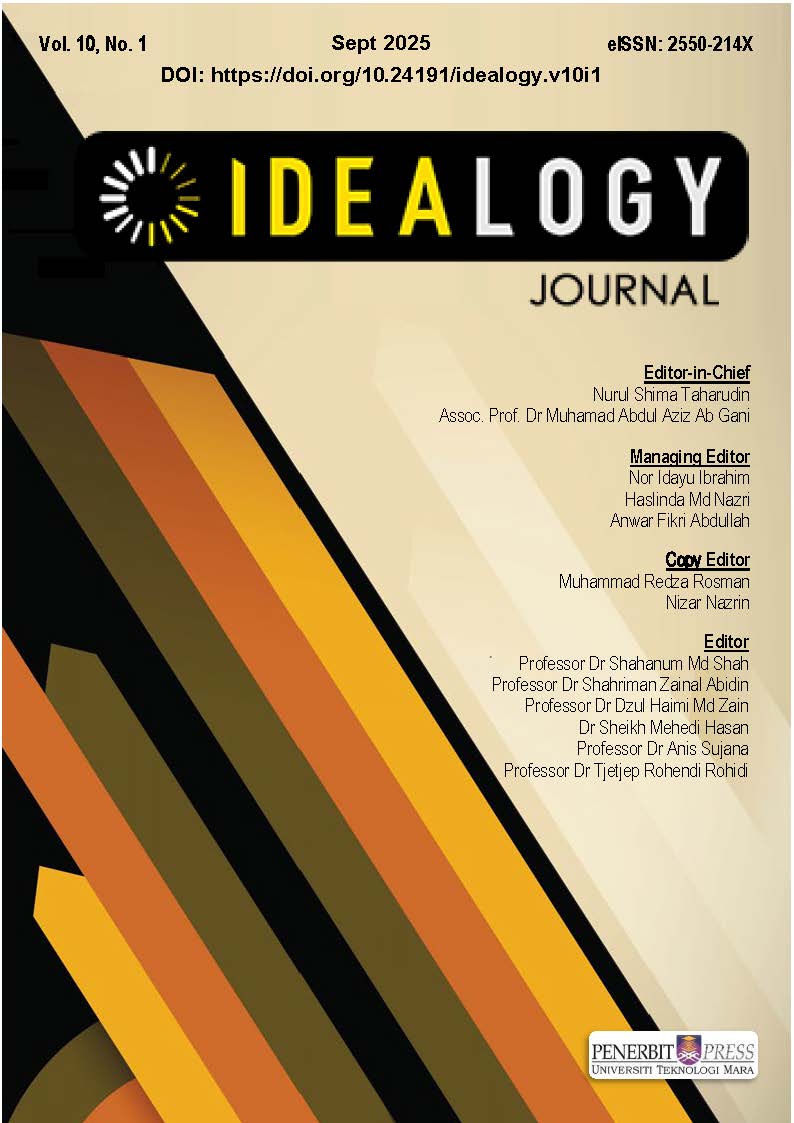Art Therapy Using Color in Paintings and Illustrations for Higher Education Students in UiTM Perak
DOI:
https://doi.org/10.24191/idealogy.v10i1.605Keywords:
Painting Therapy, Psychology of Colors, Warm and Cool Colors, Digital Painting, Higher Education StudentsAbstract
This research examined how art can become therapy for higher education students. The art therapy studied in this investigation focused on painting and illustrations, and emphasized on the use of colors in both art and daily lives. The study aimed to investigate the effects of warm and cool colors on the emotions of higher education students in the Perak area, particularly students of UiTM Perak Branch. A qualitative approach was used, consisting of case studies conducted through contextual analysis and interviews with respondents who had experience in the field of psychological art therapy, namely counselors, lecturers, and artists. Art therapy approaches, painting as a relaxation tool and the psychology of warm and cool colors were all investigated and discussed in this article. Contextual analysis and interviews covered color selection and expression, color symbolism, emotional release, awareness promotion, and non-verbal communication in art therapy, with focus mainly on paintings and illustration. Higher education students were found to have reduced stress and increased awareness through experimenting with color in this study.
References
Abdul Rahman, N. A. (2019). Irrational Re-Interpretation through Series of Emotional Portraiture Inspired by Works of Christina Otero and Clara Lieu. Idealogy Journal of Arts and Social Science, 3-10.
Abdul Wahab, N. C. (2024). Unveiling Design Gaps: An Examination of Eid Envelope Design Elements in Malaysian Banks. Idealogy Journal Vol.9, No.2., 147-155.
Ashdown, B. B. (2018). HOW DOES COLORING INFLUENCE MOOD, STRESS, AND MINDFULNESS? Journal of Integrated Social Sciences, 1-21.
Ashlock, L. M.-P.-M. (2019). The Effectiveness of Structured Coloring Activities for Anxiety Reduction. Art Therapy, 195-201.
Duel, D. (NA January, 2024). Blume Behavioural Health. Retrieved from Art Therapy for Teens: https://blumebh.com/therapy/art/
Eaton, J. T. (2018). The effects of coloring on anxiety, mood, and perseverance. . Art Therapy, 34(1), 42-46.
Houston, E. (NA NA, 2019). What is Mindful Coloring. Retrieved from Positice Psychology: https://positivepsychology.com/mindfulness-coloring-art/
Jonauskaite, D. A.-G. (2019). What color do feel? Color Research & Application, 44(2), 272-284.
Powel, A. A. (2017). Effect of coloring on students' stress levels. American Journal of Recreation Therapy, 9-16.
Riyadi, M., & Budiyani, K. (2023). Art Therapy Drawing Method for College Students with Academic Stress. Future Psychology Interaction of Human Behaviour, Culture and Technology, 1-8.
Syed Ahmad, S. O. (2021). Rumah Kutai Perak in Watercolor Painting. Idealogy Journal, vol.6, No. 2, 67-77.
Turney, S. (21 June, 2023). Frequency Distribution | Tables, Types & Examples. Retrieved from Scribbr: https://www.scribbr.com/statistics/frequency-distributions/
Downloads
Published
Issue
Section
License
Copyright (c) 2025 Idealogy Journal

This work is licensed under a Creative Commons Attribution-NonCommercial-NoDerivatives 4.0 International License.
UiTM Press (the Publisher) has agreed to publish the undersigned author’s paper in Idealogy Journal. The agreement is contingent upon the fulfilment of a number of requirements listed below.
1. The undersigned author warrants that the paper entitled below is original, that it is not in any way libellous or unlawful in Malaysia, that it does not infringe any copyright or other proprietary right. The undersigned hereby represents and warrants that he/she is the author of the paper, except for material that is clearly identified as to its original source, with permission notices from the copyright owners where required. The undersigned represents that he/she has the power and authority to sign and execute this agreement.
2. The undersigned author warrants that the paper entitled below has not been published elsewhere, and also it will not be submitted anywhere else for publication prior to acceptance/rejection by this Journal.
3. By submitting the paper entitled below, the undersigned author agrees to transfer the rights to publish and distribute the paper in an international e-journal (entitled above) to Publisher.
4. The undersigned author agrees to make a reasonable effort to conform to Publisher's submission guidelines and to liaise with the editor to ensure that the requirements of these guidelines are met to a reasonable degree.
5. The corresponding author signs for and accepts responsibility for releasing this material on behalf of any and all coauthors. This agreement is to be signed by at least one of the authors who has obtained the assent of the co-author(s) where applicable. After submission of this agreement signed by the corresponding author, changes of authorship or in the order of the authors listed will not be accepted.


